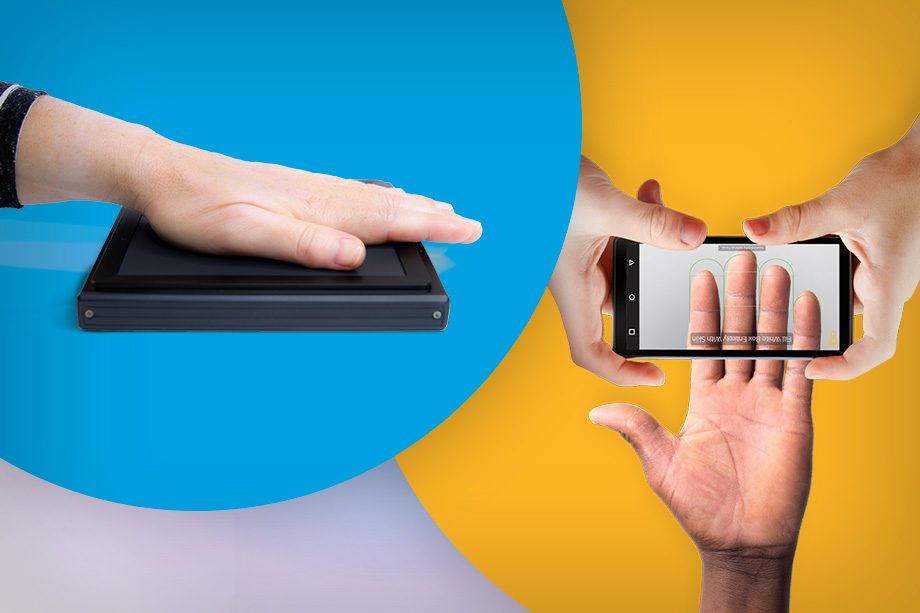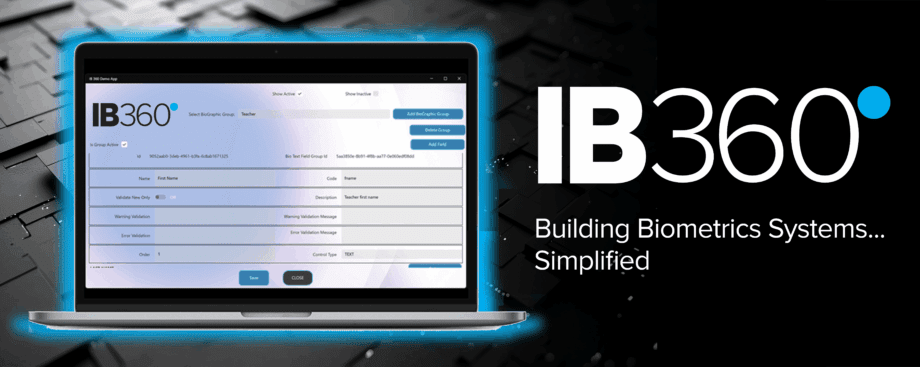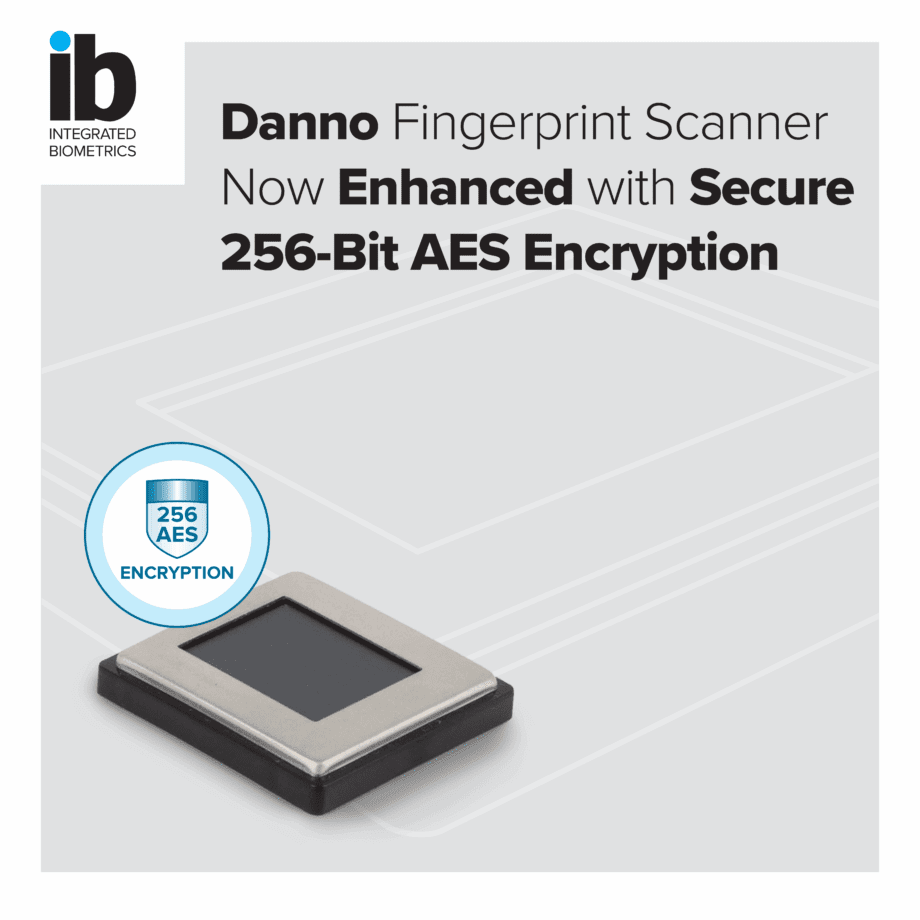Contact and contactless fingerprint scanners are often presented as competing technologies — this is misleading. A robust end-to-end biometric system that includes enrollment and verification or identification may contain both contact and contactless components, leveraging the advantages of each. Knowing how and when to deploy these differing products, is highly dependent on the environment in which the system will be used and the needs and regulatory requirements of the implementing organization.
Integrated Biometrics has been a leading provider of fingerprint scanners for over 20 years. The IB family of widely adopted FBI certified scanners employs an innovative light emitting sensor (LES) film to achieve the highest quality imagery. IB has built on this expertise in contact-based print collection to create Slapshot, contactless identification software for mobile phones and tablets. The team of engineers and scientists behind IB’s contact and contactless scanners have a deep understanding of how these fingerprint capture techniques differ, the impact on print collection and the advantages and shortcomings of each tool.
Context is Crucial
The landscape for fingerprint scanners is increasingly complex and rapidly changing. There is no ‘one-size-fits-all’ solution, the biometric system must be designed for specific cases.
Though both types of scanners capture fingerprints — their technologies and certification status differ greatly. Currently, a contact sensor is the only viable, or legally possible, solution for use cases such as law enforcement, national identification systems and border identification. Other scenarios, such as healthcare, banking and telecommunications can often leverage the mobility, ease-of-use and affordability of a non-certified contactless scanner.
Key questions to consider when creating your biometric system include:
- Does enrollment require matching the collected print with a reference database, such as a government AFIS or a national identification system?
- Is certification to NIST FBI standards, such as Appendix F, required?
If the answer to either of the questions is “yes”, then a contact scanner solution is required for the enrollment phase of the biometric system.
Contact fingerprint technology, for which IB LES contact fingerprint products represent leadership in the certified fingerprint market space, must meet recognized industry standards for fingerprint image quality and interoperability.
Creating or using your own custom database? Contactless scanners can be used for both enrollment and identification/verification. When non-certified or contactless images are used as the enrolled reference images, the accuracy of the system is less than that of a contact system. When choosing a scanner type, the required system accuracy is a key selection criteria.
Contact Sensors: Enrollment
For systems that utilize a reference database or where the consequences of failed identification would be severe, contact fingerprint scanners remain the most reliable and proven solution. Despite their great potential, contactless scanners are currently not as precise as contact scanners. Recent research by NIST on contactless devices found the images captured by these devices may have greater variability across successive captures and not perform as well in image processing and automated matching as contact collected images1. Factors that negatively impact the reliability of capture by contactless devices include poor lighting, inadequate focus and the users/operators’ handling of the device.
Currently, there is no officially recognized contactless standard; contact scanners are the only US government certified fingerprint capture devices. The National Institute of Standards and Technology and the US Federal Bureau of Investigation (FBI) created extremely rigorous certification standards for contact scanners. Devices that have achieved Appendix F certification meet the most demanding requirements for image quality and FBI interoperability standards – allowing fingerprints collected by one device to be compared with those collected on another certified device. Similarly, the independent organization iBeta accredits devices that have a Presentation Attack Detection (PAD), or ‘anti-spoofing’ capability. Those that achieve a 0% IAPAR (imposter attack presentation match rate), including many scanners in the IB product family, are awarded Level 1 compliance.
Reliance on contact scanners for enrollment in specific use cases, especially law enforcement, public safety, and others where highly accurate database creation and verification are needed will continue. Contactless enrollment will become more widespread in many scenarios where less accuracy in matching can be tolerated.
Contactless Sensors: Enrollment
Contactless fingerprint technology uses the built in camera system of a smartphone to take a “picture” of the fingers. Collected accurately and formatted properly, these images can be used for enrollment in specific use cases. With IB’s SlapShot software a mobile device’s camera captures photographs of the fingers and the proprietary algorithm collects, extracts and formats the contactless pictures into usable fingerprint images suitable for matching certified fingerprints. The quality of contactless image capture is increasing rapidly as the technology matures. Slapshot delivers an accuracy rate of 97.5%, exceeding the >97.5% NIST target.
Custom image databases are created for use in a range of scenarios such as banking, healthcare, telecommunication, access to secure facilities or private property and distribution of aid or benefits. Enrollment by contactless scanners can offer many advantages including speed and portability as they can be used in field or remote environments where contact scanners may not be feasible due to computer network connectivity or other factors. Contactless scanners do not require the operator to carry and plug in any additional peripheral hardware.
Contactless devices facilitate self-service enrollment, making it easier to reach much larger portions of the population — or a larger client base — than possible with enrollment by contact scanners at designated enrollment centers.
Identification & Verification: Contact & Contactless Options
Both contact and contactless scanners are viable options for identification and verification, matching against all database types, including reference databases. However, accuracy with non certified reference databases and contactless images will always be less than that delivered by contact-scanners and certified databases. Those contactless scanners that have not been designed specifically for matching with a contact database will also be less accurate.
The choice of scanner will be highly influenced by the use case. For self-serve identification or operations in field environments; contactless solutions that leverage cell phones to prove identity are a pragmatic option. In fixed locations, such as facility access points, both types of scanners are feasible.
A Certification Path for Contactless
As with any technological innovation, certification lags behind introduction and adoption in the marketplace. However, efforts are ongoing to create certification for contactless scanners.
In April 2023, NIST proposed a set of protocols and measurement criteria for an eventual certification program. It should be noted that this initial protocol does not include the use of contactless fingerprint scanners when a reference database of contact collected images is utilized. Furthermore, any eventual certification for contactless devices will be based on criteria from matching against an already certified and acceptable device as a reference and interoperability with contact sensor systems will be a component of certification2.
For this reason, Integrated Biometrics continue to recommend contact scanners for enrollment in specific uses such as law enforcement and border control. However, when the standard is released for contactless fingerprint images, they will be allowed to be used to do 1:N identification searches against existing certified contact databases, including FBI.
Health and Safety Concerns
Despite the end of the COVID-19 pandemic, the role of biometric scanners in the potential transmission of infectious diseases remains a concern. In our view, neither contact or contactless scanners pose a significant health risk to the public.
During actual print capture with a contactless scanner, the finger hovers over the scanner, generally at distances of 3.5 to 5 cm. By avoiding contact with the glass or other material that protects the cameras, the risk of contact with germs is mitigated.
Contact scanners manufactured by IB vastly reduce any risk of exposure to COVID-19 and other diseases. An investigation by the University of Missouri Laboratory for Infectious Disease Study on the transmission of live SARS-CoV-2 samples, found the electroluminescent (EL) film technology in IB fingerprint scanners actively killed the coronavirus through the creation of an electric field during the collection process. Following a 2-second touch, the standard collection time for an accurate fingerprint, 90 percent of the sample was killed. When combined with the 90 percent reduction during the next scan, protection against transmission between individuals increases to 99 percent or greater3.
IB scanners also offer additional protection with RepelFlex MBED, an ultra-thin and transparent anti-microbial coating. MBED actively kills bacteria making contact surfaces safer to touch and easier to sanitize with nearly any cleaner or disinfectant while also increasing resistance to scratches or stains.
IB: Optimize Your Biometric System with Industry Expertise
Fingerprint capture technology is rapidly evolving. It can be difficult to identify the true capabilities amid a sea of extravagant marketing claims. With longstanding expertise in contact scanners and the most reliable contactless software on the market, IB can ensure you create the best biometric system for your specific needs.
1 NIST Interagency Report 8488, “Repeatability of Contactless and Contact Fingerprint Capture”, September 2023. https://nvlpubs.nist.gov/nistpubs/ir/2023/NIST.IR.8488.pdf
2 NIST Special Publication 500-339 Specification for Certification Testing of Contactless Fingerprint Acquisition Devices, v1.0, April 2023. https://nvlpubs.nist.gov/nistpubs/SpecialPublications/NIST.SP.500-339.pdf
3 University of Missouri Laboratory for Infectious Disease Study Finds Technology Used in Widely Deployed Fingerprint Scanners Kills The Virus that Causes COVID-19, May 2023. https://www.prnewswire.com/news-releases/university-of-missouri-laboratory-for-infectious-disease-study-finds-technology-used-in-widely-deployed-fingerprint-scanners-kills-the-virus-that-causes-covid-19-301818908.html
About Integrated Biometrics
Integrated Biometrics (IB) is a global leader in advanced biometric technology. Renowned for revolutionizing fingerprint scanning through its proprietary, FBI-certified Light Emitting Sensor (LES) technology, the company delivers cutting-edge fingerprint scanners, seamless biometric system integration software, contactless fingerprint capture, and comprehensive identity management beginning with infant identification solutions.
Trusted by organizations worldwide, Integrated Biometrics serves critical sectors such as law enforcement, military, election validation, financial services, and national identity programs. Its robust, high-performance products enable fast and accurate enrollment, identification, and verification, even in remote and extreme environments. IB continues to redefine the possibilities of biometrics—Impacting Lives Through Identity.




